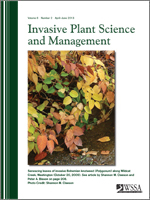The intent of this study was to determine if composting is an effective means of managing water hyacinth while producing a quality horticultural compost product. Preliminary tests for the study included germination and seed mortality tests. Germination tests found that water hyacinth seeds germinated on filter paper media soaked in distilled water while placed in petri dishes held at a constant temperature of 27 C for 14 d. Seed mortality test results found that seeds of water hyacinth were rendered inviable at temperatures equal to or above 57 C. The study successfully developed a large-scale composting system that used water hyacinth as a primary feedstock. Eleven compost piles were derived from 10,000 kg of water hyacinth, 9,000 kg of food waste, 11,300 kg of poultry litter, and 17,200 kg of wood chips. Results indicated that the composting process reached and sustained sufficiently high enough temperatures to inactivate and fully decompose seeds and other propagules of water hyacinth. Therefore, water hyacinth can be composted without the potential danger of it spreading. Compost quality tests found that the compost produced was within acceptable to ideal ranges of accepted industry quality standards, though there was a learning curve by student workers in the preparation of the piles using the large equipment.
Nomenclature: Water hyacinth; Eichhornia crassipes (Mart.) Solms
Management Implications: Water hyacinth (Eichhornia crassipes) is one of the most invasive aquatic species worldwide. It became a nationwide aquatic weed problem during the last century after its introduction to the United States in 1884 at the Centennial Exposition in New). Different means of management have been implemented in the past including herbicides and harvesting for various reasons. The plant has been successfully composted in the past, but a large scale system had not been investigated to determine if all plant propagules are destroyed in the process. The intent of this study was to determine if composting is an effective means of managing water hyacinth while producing a quality compost product for the horticultural industry. In this study, over 10,000 kg of water hyacinth, 11,300 kg of poultry litter, and 9,000 kg of cafeteria food waste were collected and mixed with wood chips in a large scale composting system. Seed mortality tests indicated that water hyacinth seed was rendered inviable at temperatures above 57 C and, therefore, field compost piles were maintained at that temperature or above. Sampling for seed from curing piles found that no seeds survived nor were present after the composting process. Compost quality tests conducted by Pennsylvania State Agricultural Analytical Services Laboratory showed that compost produced was equal to or above quality standards. An estimated 50.5 m3 of compost valued at $1,980 was created from materials that were otherwise considered problematic. Therefore, this study found that there is the potential to produce a valuable agricultural or horticultural product from composting invasive weeds while helping to manage populations of invasive species in the environment. Future studies should examine the economic feasibility of the project.





